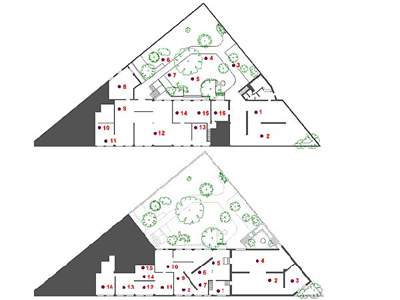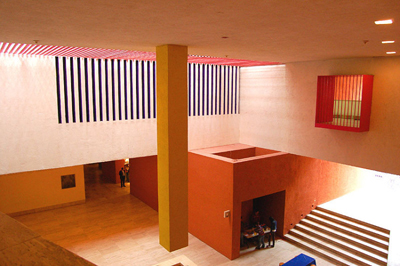Today’s entry presents three museums which are extraordinary examples of built-form and civic function. Each is a careful, intentional addition to a city or landscape, authored by master architects and designers. These projects are a bit out of the way and take extra effort to visit. The design of each focuses on the sequence of spaces and the experience of the individual navigating through the architecture & landscape. Each presents a strong and intentional relationship between inside and outside. Light and framed views are also essential to the understanding of each project.
The quality of each of these three museums is one of dimension and experience; subsequently it is difficult to capture the feel of each place through photographs.
Louisiana, Denmark
Gl. Strandvej 13, Humlebæk Tel: 4919.0719
45 minutes by train from downtown Copenhagen


The original museum was completed in 1958 by architects Jørgen Bo and Vilhelm Wohlert – an addition to the original villa on the property since 1856. Since then the museum and grounds have evolved with several conscientious and delicate additions. The sequence of spaces carefully meanders through the landscape, weaving around specific trees and ponds, intentionally guiding the visitor and framing views. The experience is tranquil.

“[The architects] wanted to increase the possibilities of enjoying the scenery, so they wandered round for months before starting to draw. They got to know the terrain literally through the soles of their feet, deciding which trees simply must be kept and studying the way the sunlight gradually moved from hour to hour.” – Louisiana



The Noguchi Museum, New York
9-01 33rd Road (at Vernon Boulevard), Queens Tel: 718-204-7088
15 minutes by subway from Manhattan

This discreet museum presents itself as a walled-off refuge in the Long Island City neighborhood of Queens. Created by Isamu Noguchi the museum opened in 1985 and presents a comprehensive collection of the artist’s works in stone, metal, wood, clay, and light sculpture. The numerous galleries wind through a converted factory building allowing passage to and through contained outdoor courtyards. The monastic, raw lower floor contrasts nicely with the warm airy galleries on the upper floor. Weather is significant to the project, and natural daylight washes over the austere walls highlighting the sculptures.


“Although the renovated Museum has a fresh look, great care has been taken to maintain the original character of the building, which was integral to Noguchi’s vision for the Museum. The raw industrial space of the former photo-engraving plant serves as a superb backdrop for the artist’s sculpture.” – Noguchi Museum

The Noguchi Museum, along with many more recommendations can be found on the Modern List Manhattan.
Museo de Arte Contemporáneo de Monterrey (MARCO), Mexico
Zuazua y Jardón S/N, Centro, Monterrey Tel: 52 (81) 8262.45OO

The museum, by architect Ricardo Legorreta, provides as an urban oasis in addition to being a centerpiece of downtown Monterrey. The sense of volume and carved openings is momentous inside and out. A series of smaller galleries encircle the expansive central interior patio which slices and filters Monterrey’s piercing sunlight. With great architectural discipline, the central patio lends much of its floor area to a shallow pool of cool water. This shaping of the sunlight upon the simple textured volumes joined with the “water mirror” compels a visitor to stop and do nothing but drink coffee and sketch all afternoon.


”Artwork is showcased by a careful, balanced arrangement of natural and artificial light, so that a visit to this museum is nothing like touring a laboratory that contains works of art, but a visit to a series of architectural spaces and elements that are, in themselves, works of art.” -MARCO






